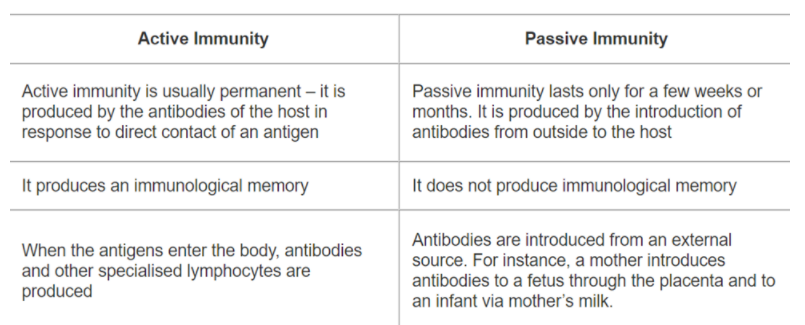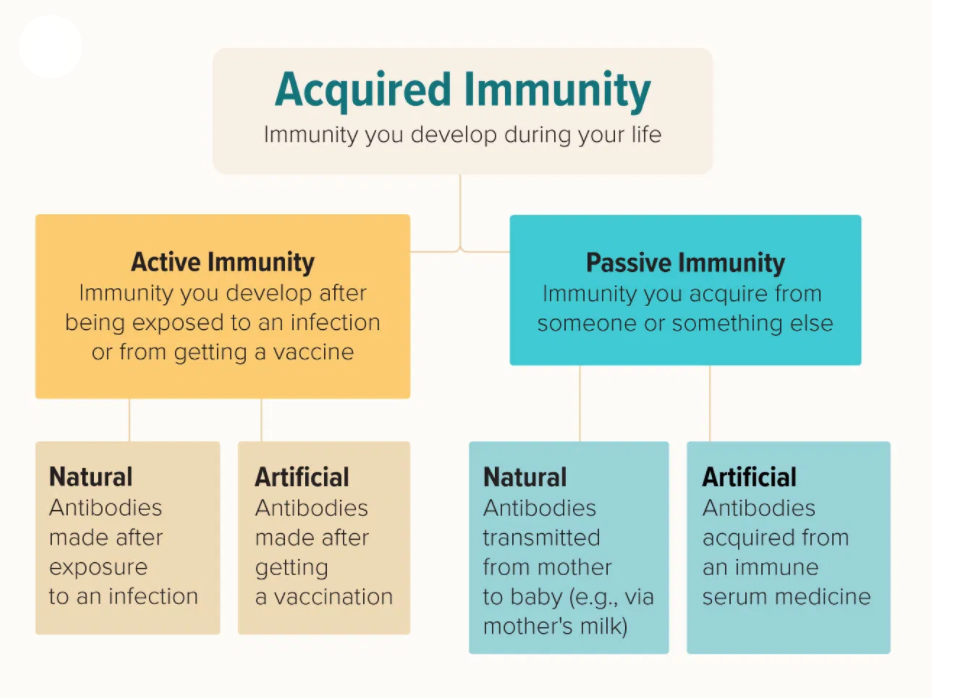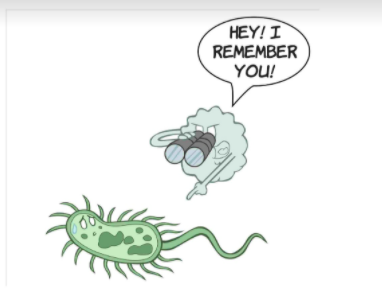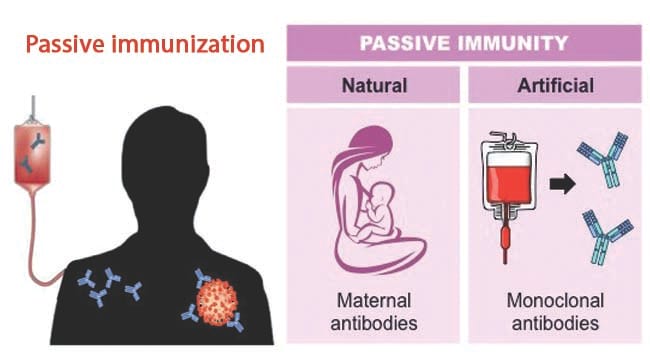Active and Passive Immunity Study Guide
Introduction
Immunity refers to the body’s ability to prevent the invasion of pathogens. Adaptive immune responses are very slow, specific and are antibody mediated, unlike innate immunity, which is non-specific and fast-acting.
There are two types of adaptive immunity: active and passive immunity. There is a distinct difference between the two, and this guide explores them in detail.
Active and Passive Immunity Overview
What is immunity? Immunity refers to the ability of the body to defend against pathogens such as bacteria, viruses, and more. This occurs through the immune response wherein specific cells within the body attack the illness and help keep the body healthy.
Active Immunity
- Active immunity refers to immunity that results from the body’s internal production of antibodies. The body activates such a response when it is in the presence of antigens.
- Active immunity is a form of long-term protection. It can be activated both naturally and artificially.
Passive Immunity
- Passive immunity refers to immunity where the body does not produce antibodies as a response to antigens. Rather, antibodies are directly introduced into the body from an external source.
- Passive immunity can be obtained both naturally and artificially.
What is Active Immunity?
-
An antigen is any foreign matter that does not belong within the body. Such antigens include bacteria, viruses, and other pathogens.
-
When an antigen enters the body, it is recognized as non-self by white blood cells known as lymphocytes.
-
There are certain receptors on the cell surface of lymphocytes that recognize non-self antigens and trigger the production of antibodies.
-
The production of antibodies is undertaken by a type of white blood cell called the B lymphocyte or the B cell.
-
When a B lymphocyte has a receptor that matches an antigen, the antigen is recognized.
-
Some B lymphocytes gathered around the antigen then develop into plasma B cells and secrete antibodies that attack the antigen
-
The remaining B lymphocytes develop into memory cells that remain in the body in case of a future attack by the same antigen.
-
This is how active immunity is created through the formation of antibodies, and in turn, the formation of memory B cells.
-
In the case of the same antigen entering the body, the corresponding memory cells are activated, leading to a quicker immune response since the antibody can be produced faster as it already exists. Memory cells are the reason that active immunity is more long-lasting than passive immunity.
Natural and Artificial Active Immunity
Natural active immunity is immunity that is acquired naturally in the body by exposure to disease organisms. For example, natural immunity to a cold can be obtained when the cold bacteria infect the body, and subsequent antibody production occurs. Resulting in the formation of memory cells against the cold antigens.
Artificial active immunity refers to immunity produced by intentional exposure of a person to antigens to produce antibodies and memory cells. For example, the administration of vaccination often leads to artificial active immunity. When vaccination is provided, it contains dead or weakened antigens that trigger an active immune response through the production of antibodies and memory cells. This causes artificial active immunity.
What is Passive Immunity?
Passive immunity is acquired when antibodies are introduced into the body from an external source.
Natural and Artificial Passive Immunity
Natural passive immunity is acquired via sources such as mother’s milk, for example. It can also be obtained through the placenta, wherein it is passed down from mother to baby. In this scenario, the antibodies created in the mother’s body are passed onto the child, obtaining immunity. However, since the child’s body has not made the antibodies, no memory cells exist, so passive immunity protects the child.
Artificial passive immunity can be acquired through anti-serums and other medicines administered to the body by doctors to cure an antigen invasion.
Conclusion
- The body has two types of acquired, adaptive immunity: active and passive immunity.
- Active immunity refers to immunity acquired through the introduction of antigens, resulting in antibodies and memory cells.
- Active immunity can be obtained naturally, through antigens entering the body, and artificially, through vaccinations.
- On the other hand, passive immunity refers to the introduction of antibodies without the presence of antigens.
- Since no memory cells are formed, it is not as long-lasting but can often be quicker to solve disease than waiting for natural antibody formation.
- It can also be acquired naturally, through breastmilk and placenta, and artificially, through medicines and anti serums.
FAQs:
1. What is the difference between active and passive immunity?

2. What is an example of active and passive immunity?
An example of active immunity is through vaccinations, and passive immunity is through the placenta.
3. What is a passive immunity example?
An example of natural passive immunity is through breast milk and the placenta. An example of artificial passive immunity is through anti-serums and other antibody administration directly into the body.
4. What are active and passive immunization?
Passive immunization is when antibodies are transferred to a recipient. In active immunization, the immune system plays an active role and results in the formation of memory cells. Active and passive immunization is essentially the same as active and passive immunity.
We hope you enjoyed studying this lesson and learned something cool about Immunity – Active and Passive! Join our Discord community to get any questions you may have answered and to engage with other students just like you! Don’t forget to download our App to experience our fun, VR classrooms – we promise, it makes studying much more fun! 😎
Sources:
- Acquired immunity. https://www.thefreedictionary.com/artificial%20passive%20immunity. Accessed Nov 25, 2021.
- Immunity. https://flexbooks.ck12.org/cbook/ck-12-biology-flexbook-2.0/section/13.50/primary/lesson/immunity-bio/. Accessed Nov 25, 2021.
- Immunizations: Active Versus Passive. https://www.pharmacytimes.com/view/immunizations-active-versus-passive. Accessed Nov 25, 2021.
- Immunity Types. https://www.cdc.gov/vaccines/vac-gen/immunity-types.htm. Accessed Nov 25, 2021.




